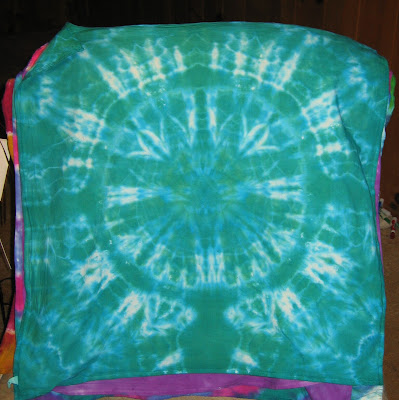Traditional shibori artists tied bolts of cotton or silk into complex patterns and then vat-dyed them to produce beautiful fabrics for kimonos. Each bolt of cloth might be tied into one pattern, dyed, untied, and then tied into a different pattern and dyed in a different color. This process might be repeated as many as 30 times, after which time the cloth was ready to be sewn into a kimono and embroidered. The production of a special kimono often took decades of work.
I use traditional shibori techniques (and a few modern tie-dye techniques that do not appear to have been derived from shibori dyeing) with modern materials and dyes. I use rubber bands instead of silk thread (usually) and squirt the dyes on instead of immersing the fabric in vats. I dye finished items instead of raw bolts of cloth.
This year, tea towels for Christmas presents.
I've been tying this batch of towels for about the past 2 years. Yesterday was dye day.
The first one here is as close to traditional as I get: kumo (spiderweb) and ne-maki (thread-resisted ring) motifs on simple cloth dyed in a color rather close to indigo:

The second is a large kumo (spiderweb) motif dyed in a single color. The turquoise is the bleeding from the aquamarine dye.
The next three all all arashi (wind-driven rain) designs. The cloth is wrapped around a pole, forced into pleats and then dyed. In traditional shibori, each cloth would be vat-dyed in one color. I used three for each cloth.
The large white areas in this first piece cry for a second dye bath, don't they? Traditional shibori techniques often left much of the cloth undyed, the better to dye the cloth again with different motifs later on.
This piece also has white areas that might welcome embellishment over over-dyeing with a pale color.







No comments:
Post a Comment